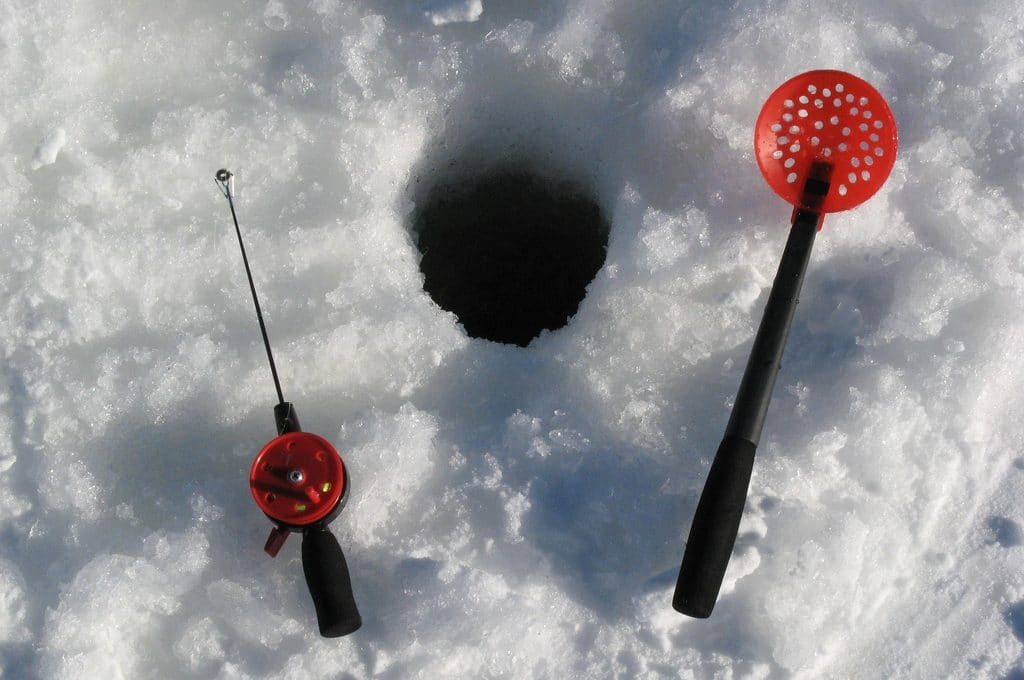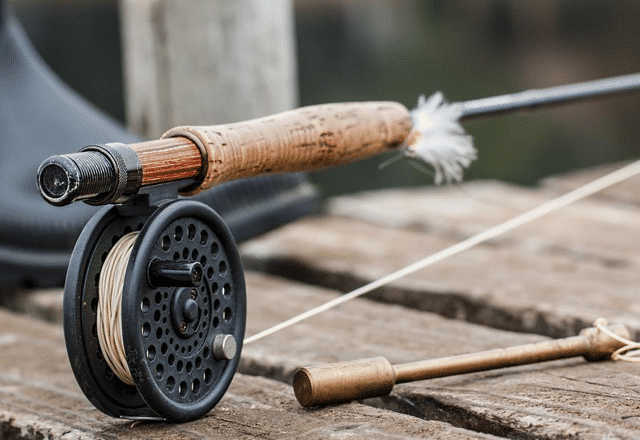If you’ve ever fished the ice, you realize the importance of only bringing the essentials. For years I was unsure of what kind of rods I should use for ice fishing because I never had anyone to guide me—I learned on my own out of interest.
Rods continue to grow in complexity, and the power and action behind the rod keeps getting more complicated. Deciding what rod to use out on the ice depends a lot on where you are fishing and what you’re fishing for. There is also the factor of personal preference and what you feel like carrying out to your holes.
1. Decide What You Are Fishing For


What are you trying to catch? This is the primary deciding factor of what type of rod you need to bring. You wouldn’t bring a knife to a gunfight just like you wouldn’t bring an ultralight rod with the intention of catching musky and pike.
I spoke with avid ice angler Doug Freehall, he said “Do not overestimate the amount of power your rods need during the winter months, the fish are much more mellow because of the cold water, so you do not need to bring out a giant heavy action rod just because you’re trying to catch some bigger fish.”
- Ultra-light Rods: Panfish
- Light Rods: Bass, Perch, Panfish
- Medium Rods: Walleye, Pickerel, Trout
- Heavy Rods: Pike, Musky
Don’t forget that the strength of your line also plays a significant role here. Having the proper test depending on what you are fishing for is almost more important than the action of your rod. There is less room to manipulate the direction of the fish when you are ice fishing which increases the chances of snapping your line. We would recommend bulking up to a specific ice fishing line that can withstand cold temperatures and relax on the power of your rod.
2. The Importance of Rod Action
Depending on what your strategy is for ice fishing you most likely will not be sitting there grasped onto your rod firmly the entire time. It is essential to detect every little nibble and tug on your lure so you can quickly set the hook and get to business. Having a rod with the right action determines how quickly you feel the nibbles and how well you can hook the fish.
- Ultra-fast action: Rod bends only at the tip
- Fast-action: Rod bends only at the tip
- Medium-action: Rod bends to the middle of the blank
- Slow action: Rod bends to the bottom of the handle
If you are using a slow-action rod, it bends so much that it would require the fish to pull your line an inch or two before you would even feel it. In ice fishing, allowing this to happen increases the likelihood of the fish getting away with your bait or evading the hook.
Fast-action rods are the best for ice fishing because you get alerted to every single nibble, and the rod has enough strength in the blank to handle larger fish.
When you are shopping around, want to take the rod and bend it at the tip to see how it flexes. This gives you an idea of how the rod would react to a nibbler so you get a feel for whether or not the rod will work for you.
3. Choosing The Rod Material


In today’s world of fishing, you are choosing between a graphite or fiberglass rod. It is hard to say that one is better than the other because it is too subjective to the individual so let’s break down the pros and cons of each.
Graphite
Graphite rods cost more, but they also perform better at setting the hook because of their increased sensitivity. These blanks are more flexible, so they bend a little quicker—which gives you a second or two extra to yank and set that hook.
If you are using a fast-action graphite rod, this would be the most ideal for ice fishing because you would get the best of both worlds: a workable tip that responds quickly and a sturdy and robust blank that keeps the fish from taking off too far. When you are ice fishing jigging is essential, so it is also essential to have a sensitive tip to allow the jig to move as natural as possible.
Fiberglass
Fiberglass rods are not as sensitive, and they are cheaper than graphite, but they do bend more along the blank which allows you to set the hook. The main upside of fiberglass compared to graphite is its durability and strength in cold weather. Graphite is fragile and does not hold up well to temperatures below freezing. If you do not want to worry about the state of your rod than fiberglass is the better option.
The decision comes down to your personal preference. I spoke with Doug Freehall about what type of rod he uses. “The sensitivity is the most important thing really; graphite is more sensitive so if you feel like you’re a bit slow reacting than go with that. All in all, the differences are so small that they are almost unnoticeable. I’d be thinking more about what kind of heater I should bring.”
4. What Size Rod Should You Use?
I do not like having too many things to carry out on the ice, but nothing is worse than forgetting something like your extra gloves or goggles (i always forget my goggles). You do not want to have any extra weight on the ice, but you need to make sure you have the right size rod for the job.
Small rods seem like the ideal option for ice fishing because they are light and do not take up as much space. These rods are fine if you do not intend on catching anything bigger than some panfish or perch. Short rods do not have enough blank to handle the fight which results in snapping your line, followed by violent cussing.
The large rods may be a pain to carry out there, but they’ll absorb the shock of hooking a large fish, and as long as you got everything else right, you should have no problem reeling him in. If you are using an ice fishing shelter or fishing in a tight space, a large rod might not be the most logical decision though.
Fishing rods are measured from tip to butt, and the most common ones run between six and eight feet. Anything larger is unnecessary for ice fishing, and anything smaller should be reserved for small panfish. Four-foot rods are also perfect for children because they are safer and they make every fish a battle.
5. Don’t Overlook The Eyes

 The amount and size of eyes on your fishing rod is something that is completely overlooked when it comes to ice fishing, but it’s something you need to pay attention to. When fishing in the warm water, it doesn’t matter that much but if you are ice fishing you want large eyes on your rod to allow chunks of ice and slush to run through without getting caught.
The amount and size of eyes on your fishing rod is something that is completely overlooked when it comes to ice fishing, but it’s something you need to pay attention to. When fishing in the warm water, it doesn’t matter that much but if you are ice fishing you want large eyes on your rod to allow chunks of ice and slush to run through without getting caught.
If the eyes are too small on your rod, you will spend a ton of time cleaning the ice off, and you also run the risk of weakening the strength of your line. Plus, no one wants to clean the rod after every single drop when it’s cold and windy. Having a good diameter set of guides on your rod is the most forgotten factor to consider when choosing an ice rod.
When you combine all these tips and consider your personal preference and feel you should have no problem choosing the perfect ice fishing rod. Everyone is different, so the only way to know your rod is the right choice is to pick it up and feel it out. If it makes sense for your style and feels good in your hands, grab it and get to business.





